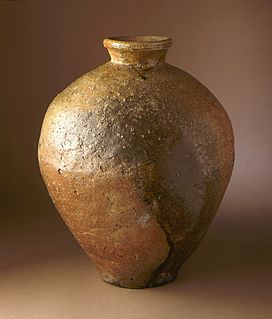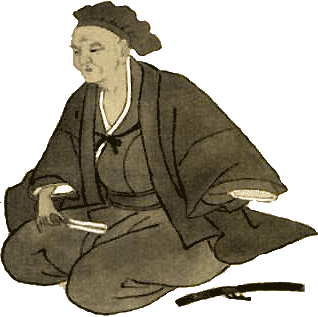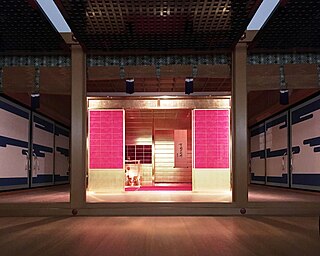
In traditional Japanese aesthetics, wabi-sabi (侘寂) is a world view centered on the acceptance of transience and imperfection. The aesthetic is sometimes described as one of beauty that is "imperfect, impermanent, and incomplete". It is a concept derived from the Buddhist teaching of the three marks of existence, specifically impermanence, suffering and emptiness or absence of self-nature.
A tea ceremony is a ritualized form of making tea practiced in Asian culture by the Chinese, Korean, Japanese, Indian, Vietnamese and Taiwanese. The tea ceremony, literally translated as "way of tea" in Japanese, "etiquette for tea" or "tea rite" in Korean, and "art of tea" in Chinese, is a cultural activity involving the ceremonial preparation and presentation of tea. The Japanese tea ceremony is better known, and was influenced by the Chinese tea culture during ancient and medieval times, starting in the 9th century when tea was first introduced to Japan from China. The Vietnamese tea ceremony, also influenced by its Chinese counterpart, is only performed during weddings and other religious rituals. One can also refer to the whole set of rituals, tools, gestures, etc. used in such ceremonies as tea culture. All of these tea ceremonies and rituals contain "an adoration of the beautiful among the sordid facts of everyday life", as well as refinement, an inner spiritual content, humility, restraint and simplicity "as all arts that partake the extraordinary, an artistic artificiality, abstractness, symbolism and formalism" to one degree or another.

Shigaraki ware (信楽焼) is a type of stoneware pottery made in Shigaraki area, Japan. The kiln is one of the Six Ancient Kilns in Japan. Although figures representing the Tanuki are a popular product included as Shigaraki ware, the kiln and local pottery tradition has a long history.
The history of tea in Japan began as early as the 9th century, when the first known references to tea were made in Japanese records. Tea became a drink of the religious classes in Japan when Japanese priests and envoys sent to China to learn about its culture brought tea to Japan. The Buddhist monks Kūkai and Saichō may have been the first to bring tea seeds to Japan. The first form of tea brought from China was probably brick tea. Tea became a drink of the royal classes when Emperor Saga, the Japanese emperor, encouraged the growth of tea plants. Seeds were imported from China, and cultivation in Japan began.

Mizuya is the term for the preparation area in a Japanese tea house (chashitsu) or attached to any venue used for the Japanese tea ceremony. For instance, the area used for preparation during outdoor tea ceremonies is also called the mizuya. The term mizuya can also refer to purificatory fonts at shrines and temples, as well as to storage cupboards for use in kitchens. This article, however, focuses on the tea ceremony mizuya.

A chawan is a bowl used for preparing and drinking tea. Many types of chawan are used in East Asian tea ceremonies. The choice of their use depends upon many considerations.

"Schools of Japanese tea" refers to the various lines or "streams" of the Japanese Way of Tea. The word "schools" here is an English rendering of the Japanese term ryūha (流派).

Chabana is a generic term for the arrangement of flowers put together for display at a Japanese tea ceremony, and also for the wide variety of plants conventionally considered as appropriate material for such use, as witnessed by the existence of such encyclopedic publications as the Genshoku Chabana Daijiten [All-color encyclopedia of chabana]. The method of arranging the flowers is according to the nageire, or thrown in, style of flower arranging. In turn, nageire is recognized as a certain stylistic category of Kadō, the Japanese "Way of Flowers". These all developed from ikebana, which had its origin in early Buddhist flower offerings (kuge). Chabana, however, refers specifically to the flower display in the room or space for chadō, and though it fundamentally is a form of ikebana, it comprises a genre unto its own.

Murata Jukō is known in Japanese cultural history as the founder of the Japanese tea ceremony, in that he was the early developer of the wabi-cha style of tea enjoyment employing native Japanese implements. His name may also be pronounced Murata Shukō.
Hechikan was a 16th-century Japanese tea connoisseur and poet from Kyoto.
Furuichi Chōin (1452–1508) was a minor Japanese lord and cha-no-yu aficionado during the Sengoku period. A disciple of Murata Jukō, he was the recipient of Jukō's treatise on the tea ceremony, Kokoro no fumi. He also received the Shinkei Sōzu Teikin, an essay on the composition of renga poetry, from Inawashiro Kensai.

Kaiseki (懐石) or kaiseki-ryōri (懐石料理) is a traditional multi-course Japanese dinner. The term also refers to the collection of skills and techniques that allow the preparation of such meals and is analogous to Western haute cuisine.

Ueda Sōko-ryū (上田宗箇流) is a cultural aesthetic practice, or tradition, of Japanese tea ceremony that originated within the samurai class of feudal Japan. The tradition is commonly called the Ueda Sōko Ryū or Ueda Ryū. The founder from whom the tradition takes its name was Sengoku period warlord Ueda Sōko. The customs, etiquette and values of the samurai are woven throughout all aspects of the tradition's practice of chanoyu, a practice that has continued unbroken for over 400 years.

The Golden Tea Room was a portable gilded chashitsu constructed during the 16th century Azuchi–Momoyama period for the Japanese regent Lord Toyotomi Hideyoshi's tea ceremonies. The original room is lost, but a number of reconstructions have been made.

Ueda Sōko (上田宗箇) (1563–1650) was a warlord who lived during the Momoyama and early Edo Periods. He is best known for founding the Ueda Sōko-ryū, a warrior class school of Japanese tea ceremony from Hiroshima. Ueda Sōko went by the name Satarō (佐太郎) in his younger days and later Shigeyasu (重安). He received his Zen practitioner's name of Chikuin (竹隠) by the 111th patriarch of Daitoku-ji, Shunoku Sōen. Today his death plaque is enshrined at the Sangen-in sub-temple of Daitoku-ji, beside that of his long time teacher in the Way of Tea, Furuta Oribe. Sōko was held in high esteem by Toyotomi Hideyoshi for military exploits and as a tea master. In the Battle of Sekigahara (1600), Sōko sided with Toyotomi's Western Army and was thus defeated. During the Siege of Osaka Summer Campaign (1615), Sōko fought with Asano Yoshinaga on the Tokugawa side, and for this Sōko was given a pardon by Tokugawa Ieyasu. In 1619, the Tokogawa shogunate assigned the Geishū Domain to Asano Nagaakira and Sōko relocated to Hiroshima serving Nagaakira. Sōko was given a fief of 17,000 koku of rice in west Hiroshima and the role of Chief Retainer of the Geishū Domain under Asano.


















